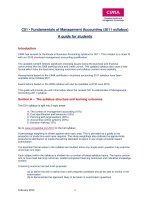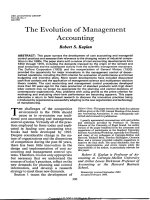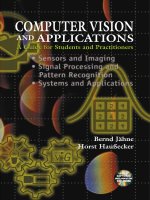C01 - Fundamentals of Management Accounting (2011 syllabus) A guide for students pot
Bạn đang xem bản rút gọn của tài liệu. Xem và tải ngay bản đầy đủ của tài liệu tại đây (197.85 KB, 7 trang )
February 2012 1
C01 - Fundamentals of Management Accounting (2011 syllabus)
A guide for students
Introduction
CIMA has revised its Certificate in Business Accounting syllabus for 2011. This revision is a closer fit
with our 2010 chartered management accounting qualification.
The updated content reflects significant emerging issues facing the business and financial
communities like the 2008 banking crisis and credit crunch. The updated syllabus also uses a new
format which links the lead aims, learning outcomes and syllabus content more explicitly.
Assessments based on the CIMA certificate in business accounting 2011 syllabus have been
available since October 2011.
Examinations based on the 2006 syllabus will also be available until 30 June 2012.
This guide will provide you with information about the revised C01 Fundamentals of Management
Accounting 2011 syllabus.
Section A – The syllabus structure and learning outcomes
The C01 syllabus is split into 5 topic areas:
A: The context of management accounting (10%)
B. Cost identification and behaviour (25%)
C: Planning with organisations (30%)
D: Accounting control systems (20%)
E: Decision making (15%)
Go to www.cimaglobal.com/C01 for the full syllabus
A percentage weighting is shown against each topic area. This is provided as a guide to the
proportion of study time each area requires. The study weightings also indicate the approximate
proportional distribution of marks that will be allocated to topics in any single computer based
examination.
It is essential that all areas in the syllabus are studied, since any single exam question may examine
more than one topic.
Each subject within the syllabus is divided into a number of broad syllabus topics. The topics contain
one or more lead learning outcomes, related component learning outcomes and indicative knowledge
content.
A learning outcome has two main purposes:
(a) to define the skill or ability that a well prepared candidate should be able to exhibit in the
examination
(b) to demonstrate the approach likely to be taken in examination questions.
February 2012 2
The learning outcomes are part of a hierarchy of learning objectives. The verbs used at the beginning
of each learning outcome relate to a specific learning objective.
The following table lists the hierarchy of learning objectives and verbs used by CIMA.
In the CIMA Certificate in Business Accounting syllabus only verbs from levels 1, 2 and 3
(knowledge, comprehension and application) are used in the component learning outcomes and
therefore only verbs from these three levels can be used in the assessments.
LEARNING OBJECTIVE
VERBS USED
DEFINITION
Level 1 | KNOWLEDGE
What you are expected to know.
List
Make a list of
State
Express, fully or clearly, the details of/facts of
Define
Give the exact meaning of
Level 2 | COMPREHENSION
What you are expected to understand.
Describe
Communicate the key features
Distinguish
Highlight the differences between
Explain
Make clear or intelligible/State the meaning or
Purpose of
Identify
Recognise, establish or select after
Consideration
Illustrate
Use an example to describe or explain
Something
Level 3 | APPLICATION
How you are expected to apply your knowledge.
Apply
Calculate
Put to practical use
Ascertain or reckon mathematically
Demonstrate
Prove with certainty or to exhibit by
practical means
Prepare
Make or get ready for use
Reconcile
Make or prove consistent/compatible
Solve
Find an answer to
Tabulate
Arrange in a table
Level 4 | ANALYSIS
How you are expected to analyse the detail of what you
have learned.
Analyse
Categorise
Examine in detail the structure of
Place into a defined class or division
Compare and contrast
Show the similarities and/or differences
between
Construct
Build up or compile
Discuss
Examine in detail by argument
Interpret
Translate into intelligible or familiar terms
Prioritise
Place in order of priority or sequence for action
Produce
Create or bring into existence
Level 5 | EVALUATION
How you are expected to use your learning to
evaluate, make decisions or recommendations.
Advise
Evaluate
Recommend
Counsel, inform or notify
Appraise or assess the value of
Propose a course of action
February 2012 3
Example from 01 Fundamentals of Management Accounting syllabus
Component learning outcome – ‘Explain the importance of cost control and planning within
organisations‟
The verb „Explain‟ is from Level 2 in the learning objective hierarchy. Therefore an assessment
question based on this component learning outcome could use one of the verbs from level 2 or from
the lower level 1 but a higher level verb could not be used to test this learning outcome.
The skills or ability demonstrated at level 4 (analysis) and level 5 (evaluation) will not be examined at
the Certificate level and verbs from these levels will not be found in the component learning outcomes
for any Certificate syllabus.
Section B – Studying for C01 Fundamentals of Management Accounting
We recommend that, wherever possible, you attend a course taught by an approved CIMA Learning
Quality Partner. Visit our college list at www.cimaglobal.com/colleges to find details of colleges local
to you that teach the Certificate level.
The official CIMA study texts have full syllabus coverage for each new Certificate subject.
Please remember that exams based on the CIMA certificate in business accounting 2011 syllabus
have been available since 3 October 2011 and exams based on the 2006 syllabus will also
be available until 30 June 2012.
Please ensure you are using the correct syllabus textbooks or learning material for the exams
you intend to sit. Find out more and order your copies of the CIMA study texts from CIMA
Publishing.
You can also study for the certificate subjects with CIMAstudy.com - the CIMA endorsed online study
system.
Each subject has a „Study Resources‟ area on the website. From here you will find guides, reading
lists and useful articles.
Question practice is an important part of preparing for the exams – find more information about
practice questions for C01.
CIMAsphere, our online community, provides a resource for students to share information and find
expertise and support among peers, as well as gain advice from CIMA members and alumni. See the
certificate level discussion board.
You can choose to study for and take the five Certificate exams in any order and combination to suit
your own study requirements. See Section F of this guide for links to further guidance.
Section C – Assessment strategy and assessment information
All exams under the 2011 Certificate syllabus are computer based. You can sit the exams at any time
of the year in one of our accredited computer based assessment centres worldwide
Find full details about entering certificate exams here.
February 2012 4
For C01 Fundamentals of Management Accounting there will be a two hour computer based
assessment, comprising 50 compulsory questions, each with one or more parts.
A variety of objective test question styles and types are used within each of the assessments. The
most common type of objective test question is multiple choice. We also use other types of objective
test questions such as matching pairs of text and graphic, sequencing and ranking, labelling diagrams
and single and multiple numeric entry.
Guidance will normally be given with regard to the rounding of answers, for example “to 2 decimal
places” or “to the nearest £” . If no guidance is given, then candidates should give their answers to 2
decimal places.
Examples of objective test questions for C01
Example question 1
The difference in the values (£) between point X and point Y on the profit volume chart shown above
represents:
A contribution
B profit
C breakeven
D loss
Example question 2
X Ltd manufactures a product called the “ZT”. The original budget for next year was:
Annual sales 10,000 units
£ per unit
Selling price 20
Variable cost 14
Fixed costs 3
Profit 3
If the selling price of the ZT were reduced by 10%, the sales revenue that would be needed to
generate the original budgeted profit would be £
____
February 2012 5
Receive results and feedback when you finish
The pass mark for each Certificate exam is 50%. A permanent credit is awarded to you if you score
50% or more.
You will see your results and indicative feedback onscreen as soon as your assessment has finished.
It will take between five and seven days for your results to show in your MY CIMA account.
If you are successful, you will receive a certificate of achievement and your exam status will
automatically be updated at CIMA.
If you are unsuccessful, the feedback will show where you should focus your studies in the syllabus.
You can arrange your resit when you are ready.
Calculators
Keep up to date with guidance on using calculators in the Certificate computer based assessments at
www.cimaglobal.com/exams
February 2012 6
Section D – Syllabus comparison
2011 C01 syllabus
2006 C01 syllabus
Comparison and comments
A. The context of
management accounting
10%
A new section, introducing the
concept of management accounting,
and the role of the management
accountant. It considers both
CIMA‟s definitions, as well as those
of IFAC. It also explores the role
that CIMA plays on behalf of various
stakeholders.
B. Cost identification and
behaviour 25%
A. Cost Determination 25%
This section is an amalgamation of
2006 syllabus‟ Cost Determination,
and Cost behaviour and Break Even
analysis. The FIFO, LIFO and
AVCO methods of accounting for
stock have been removed (but still
appear in C2).
C. Planning with
organisations 30%
C. Standard Costing 15%
This section combines 2006‟s
Standard Costing and Financial
Planning and Control. Piecework
and the principles of incentive
schemes have been removed.
E. Financial Planning and
control 20%
All of this 2006 section is covered in
Planning with Organisations.
D. Accounting control
systems 20%
D. Costing and Accounting
Systems 30%
This section has merely been
renamed, plus the weighting has
reduced from 30% to 20%.
E. Decision making 15%
B. Cost behaviour and Break
Even Analysis 10%
Most of this section is lifted from the
2006 Cost behaviour and Break
Even Analysis. NPV and IRR has
transferred from the 2006 C3 paper;
and the payback method is new.
February 2012 7
Section E – Exemptions
You may be exempt from some or all of the CIMA Certificate in Business Accounting exams if you
have a relevant degree, have completed the AAT Technician stage, or have studied another
professional accounting qualification. You can find more information at
www.cimaglobal.com/exemptions
Before accepting any exemptions you should consider the CIMA syllabus for the subject and make
sure you are confident that you could pass it. This material will be built on in the later stages of
CIMA‟s Professional qualification so it is important that you have a thorough understanding and good
knowledge of any subject before accepting an exemption.
Section F - Useful reading
The CIMA certificate in business accounting 2011 syllabus (PDF 1MB).
Transition arrangements (PDF 27KB) between the 2006 and 2011 syllabi
Suggested study route and paper combination options (PDF 27KB).
Article published in the July/August 2011 issue of Financial Management summarising the subject
changes.
Article published in the April 2011 issue of Velocity giving guidance on starting to study the certificate
level including suggestions on how long you should aim to complete it in, study times and advice on
which order to complete the subjects
Tips from students
Struggling with business English?
Struggling with mathematics?
Other useful articles from Financial Management and Velocity









